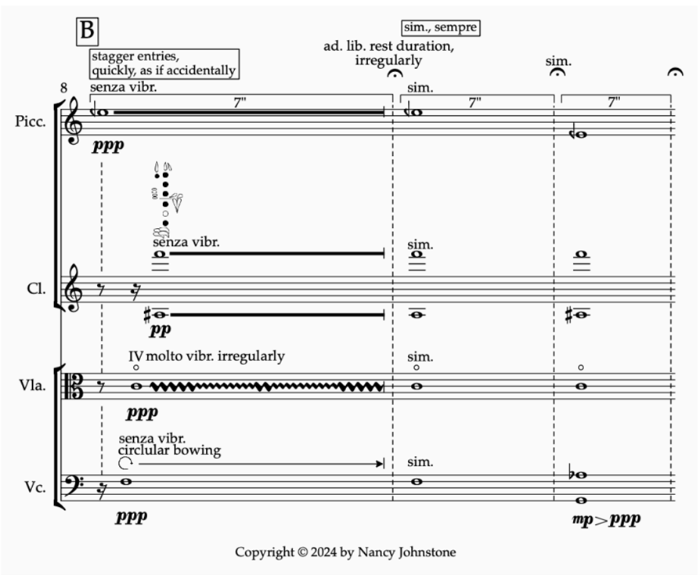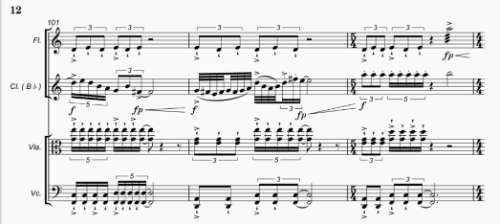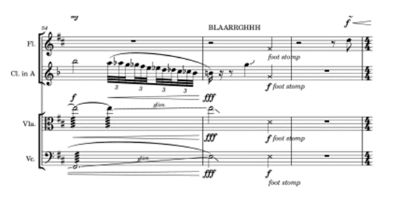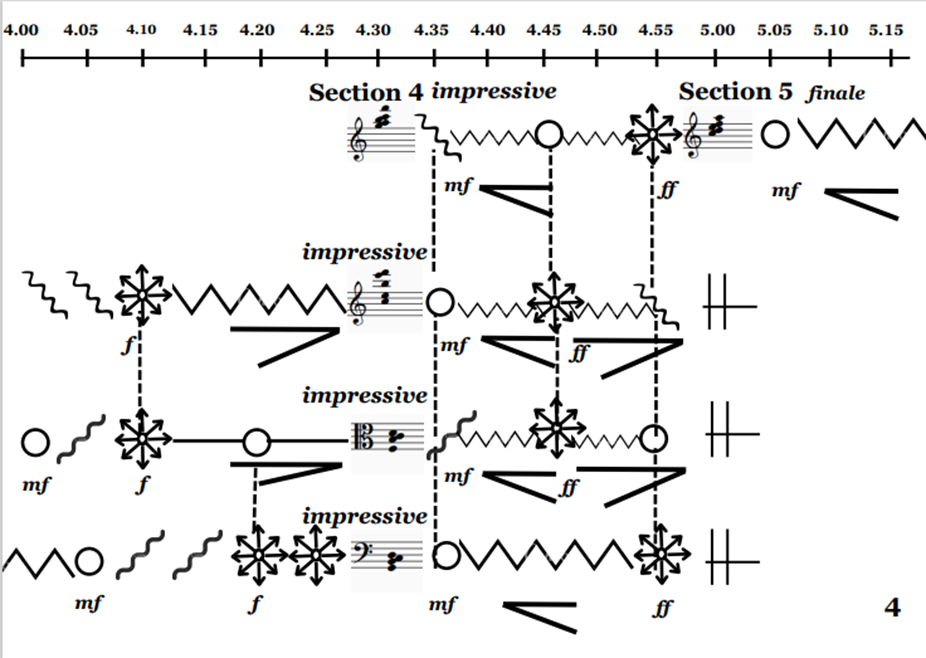2023-24: Inspired!
One of the wonderful things about looking after the University Art Collection is finding out about the many ways in which people respond to the artworks we hold. It is always a delight to speak with visitors to our gallery and to listen to their interpretations of the works on display. Their views often encourage me to look again and to consider familiar art in a new way.
The Pathfoot Project, which works with students from both the University of Stirling and the Royal Conservatoire, is always a joy for us and the creative responses they produce annually has in no small way resulted in the theme of our 2023-24 exhibitions. Our chosen focus this year is Inspired! in which we are celebrating how the beautiful University of Stirling campus and our Collections have inspired creativity in many ways.
No one who spends time at Stirling can help but be moved by the beauty of our natural surroundings, and the experience of being here is reflected in our exhibitions this year. Works on display include the Pathfoot Sounds, a sound installation reflecting the architecture and fabric of the Pathfoot building as well as the people who work and study within; The Airthrey Dance Trail, an immersive outdoor dance and poetry experience looking at the trees which live on our campus; and Airthrey, a commissioned artwork of the campus by artist Babs Pease.
Our collections have also provided creative inspiration for new artworks this year. Interior Dialogue by artist Christine Borland was created in response to the artist’s long-held emotional and intellectual engagement with Barbara Hepworth’s work, whose sculpture Figure (Archaean) was one of the founding works of our Collection. The inspiration for our main Crush Hall exhibition of works from the permanent collection came from a single painting: Cadmium and Light Red by Patrick Heron. And the works of Willie Rodger explore the inspiration provided to a wide variety of people by this artist.
The responses of students from the M.Litt in Creative Writing here at Stirling and Composition students from the Royal Conservatoire contained within this booklet perfectly encapsulate the myriad of responses which artworks can invoke, and I hope that they will inspire you too.
Sarah Bromage
Head of University Collections
Our campus here at the University of Stirling is one of our greatest assets. I sit writing this introduction having walked into work past the Wallace Monument and then by the loch with its resident swans. Outside my window, in one of the courtyards of the Pathfoot Building, a colony of gulls is squawking at a volume that must be interrupting classes. And, in a moment, I will leave my desk to get a coffee and pass by sculpture and artwork that will make me pause, as it always does, and think again about how lucky we are to be surrounded by such inspirational landscapes, buildings, objects and paintings.
This pamphlet collection essentially asks our MLitt in Creative Writing students to do exactly that: to pause and take a moment to reflect on the campus around them. They’ve done this superbly, with short pieces of prose and poetry not only inspired by the wonderful exhibitions of the Pathfoot Art Collection, but also by antique furniture dating back to the foundation of the university, a historic printing press recently restored to full operation, and the iconic ‘blue boy’ statue which sits on the hill in front of Pathfoot as a memorial to the first principal Tom Cottrell.
The writing here is, by turns, lively and reflective; buzzing with ideas and retreating to a moment of calm. Just like the campus. For the first time in this pamphlet project – now in its seventh iteration – we also have a collaboratively written poem which is presented as a conversation between two speakers suggested by one of the artworks. This encapsulates our intentions with this project – to bring together different forms and voices, to draw inspiration from both campus and our exhibitions that can prompt our creativity, and to work collaboratively. We hope you enjoy the pieces and use them to explore and respond to the campus anew. In doing so, please do also take note of the names of the featured writers because you’ll hopefully be seeing plenty more writing from them in the years to come…
Dr Liam Bell
Senior Lecturer in Creative Writing
Our composers at the RCS have a wide range of interests and musical backgrounds, but are all interested in collaborating and finding a definition for collaboration which will fit within their own practice. This project has therefore been a highlight of our calendar over the last few years, allowing our composers to draw on Sarah's knowledge of the collection, respond to one or more of the artworks that can be seen in and around the building, and then to work directly with professional musicians, to create new pieces of music that are linked to the Pathfoot Building and its fantastic collection of art.
Oliver Searle
Head of Composition
The Boy
Isaac Hattam, inspired by Iain McColl’s ‘The Pursuit of Knowledge’
Time is a strange thing. It keeps moving on. History amalgamates behind it, leaving only a desperate attempt to retain memories as the years catch up. Yet nothing is ever truly forgotten if some trace still remains.
His expression is not captivating, his demeanour not encouraging as he slouches on his seat. Yet he sits on a pedestal on a level with the trees, and so I wonder why.
Yes, time is strange.
Years of walking back and forth across its view, and never did I know what it meant until now. The crystal is hardly jewel bright, its glow not obvious to passers-by, but look closely and you will know the truth. Look closely and you will know just what he is doing up there.
Perhaps let someone tell you the story one day. The story of a small building by a loch and a forest, where people went to learn about what they had chosen to do. Perhaps they will tell you of the courtyard. Where once croquet was played, and now commemorative art is displayed.
Perhaps they will say of the canteen that held graduations before the modern sporting prestige.
Or will they tell you more about the boy himself? The founder of the idea he would never see to fruition, and so a building bears his name as the principle is lived by everyone else. Will they tell you of the crystal in which he gazes to the future, wondering just what it may become? The endless refractions and reflections of possibility and ponderance that carry every inspiration to its zenith.
And just as Tom Cottrell hoped, so I am left to wonder. From an institution of specialism to a community of possibility, just what will come next from that crystal shard.
And where do we go from here?
Forgiveness
Guadalupe Pereira Pinar, inspired by John Byrne’s ‘Angel – Blue and Gold’
Your name signifies mind, but I have lost mine. Forgive me.
I will ask for forgiveness to all of those who were injured by my arrows across the centuries. Odiseo and the twenty human years he bled before stretching his wife in his arms. Orpheo and the music accompanying him to Hades just to come back without his Euripides. Achilles and the arrow that separated him from Patroclus, segmenting the life of thousands of Trojan warriors with it.
Forgive me.
I ask all of you now for forgiveness. I did not know the power of these weapons I carry between my wings like a vulgar scholar carries his dictionary.
Mother. You who are the mark of beauty among mortals and deities, nymphs, goddesses, and even among the bubbles of sea foam that witnessed your birth. You who commanded me to hurt the mortal creature who threatened you. You, too, must forgive me. The only one whose heart has been broken is me.
And you.
My first light of sunrise. My water of the calmest sea. My pearl, my soul. My Psyche. You, among all, are the one who must forgive me the most.
Unspeakable events await for you, an uncertain future, a painful life before you are crowned by Father as a deity by my side. And all because I love you.
Psyche, forgive me.
Psyche, forgive my love.
Psyche, forgive the fact that I spy on you now from the skies, like I have done since the moment I laid my eyes on you.
I am no longer powerful Eros, but a pathetic handful of tangled love.
Your name signifies mind, but I have lost mine.
Excerpt from PALALOIS
Nancy Johnstone, inspired by Norman McLaren’s, ‘To Biddy’
‘Palaios’ means ‘Ancient’. This piece is inspired firstly, by a painting ‘To Biddy’, by Norman McLaren from the University of Stirling Art Collection, which reminded me of cave paintings, leading me on to the discovery of the Geißenklösterle Flute. Exploring how this prehistoric, pentatonic, bevelled flute may have been played, PALAIOS experiments with the effects of cave acoustics through a contemporary perspective.

Musings of a Monster
Aubrey Aloi, inspired by Alan McGowan’s ‘You Kiss No More?’ and ‘Faust as Mephistopheles
“Was I, then, a monster, a blot upon the earth, from which all men fled and whom all men disowned?”
—Mary Shelley, Frankenstein
She began sewing me together with ink and dissections of herself; with rotten parts of the things that disturbed her. I was an amalgamation of all she could not say aloud, and the people she could not be, and the faces she could not bring herself to love. I was to be her life’s many abominations stitched onto a page.
My identity sparked the night she lost her virginity to her husband atop her mother’s gravestone. Through hazel eyes I saw how the world held contempt for her and Percy. My traits were born of her love for wine and laudanum; my broodings first struck from his godlessness and ghost stories.
The day her new-born stopped breathing; the flicker of life that could have been was written into me. She filled my veins with blood from her fountain pen; she stuffed my limbs with torn and crumpled pages from her floorboards. I was a writer’s disappointment embodied, until one day, she saw me sitting on a shelf for sale. Wrapped in leather hard back binding some would joke was human skin, and still she smiled. She dazzled at the cover, titled in gold foil lettering. Something valuable. Shining.
Now I hold up space in every bookstore, in every corner of the world. I was so full of her love and hate, her cold honesty, that it stole us honour in the minds of writers long beyond her death.
But once, I was merely the monster caged inside the mind of a mad woman.
And I will always be Mary Shelley’s Frankenstein.
Calling of the Dark Forest
Amanda Hahn, inspired by Philip Braham’s ‘Augustowska 3 (Dark Trees)’
The forest calls to me, dark shadows against the bark. Wind tickles my cheeks, sharp pin pricks down, caressing my face. Pulling me closer to its welcoming darkness, like a blanket of mystery.
Echoes of beasts, wind, and creatures communing. I long to escape to simplicity, like my ancestors long ago. To be with the dark wood and forget the trials and discord of the human world. Getting closer to the entrance, louder and louder in my mind, keep going keep going.
Excerpt from HINDRANCES
Flynn Bulter Fraser, inspired by Robin Phillipson’s ‘Martyr’
‘Hindrances’ was composed as part of the University of Stirling’s ‘Inspired!’ exhibition (2024). The premise of the piece took inspiration from the structure of Robin Philipson’s painting ‘Martyr’, which I found quite sectional, owing to its abrupt contrasting panels. This piece in no way seeks to be a direct musical equivalent of the work, but instead takes the underlying composition of the painting as a starting point.

A Conversation in Mallaig
Haesel Elizabeth Dayton-Oxland and Ashley Aitken, inspired by Jon Schueler’s ‘Night Sky: Magda’
It’s so barren,
That spilling, drifting grey.
It’s peaceful isn’t it.
The swirling clouds dancing in an endless sky.
It dims my sight,
That wind dulls my ears. The air carries salt and gull song,
Stirring with the crashing waves.
Stinging and screeching,
My frigid fingers ache. Here, hold my hand.
Let winter’s brisk kiss mark our cheeks.
At least, my love,
There is warmth in your smile. Each cotton cloud as soft as your touch
Each storm a mild breeze when faced with us.
Dunvegan
Lorraine McLelland, inspired by the AH McIntosh Dunvegan Teak Sideboard (1960-69)
My grandmother died when the snowdrops lost their bloom and hare breeding season was barely underway. That final afternoon, encased in Portuguese embroidered bed linen, her fading frame propped up with pillows, fragile in her powder blue nightie, she explained through her pained smile how the females boxed the males when they were too insistent with their mating desires. Then she chuckled, and I wondered if she had ever boxed grandad.
Gran had met her husband while holidaying in Dunvegan where his family had worked for many generations at the castle. They bought the sideboard in honour of his heritage, placing it centre stage in the drawing room. Then a few years later he was locked away.
Crouching on my knees to replace the delicate Marigold Princess China cups in the grand Dunvegan sideboard, my nose drawn to the Mr Sheen scent above my head, I was surprised by an aged manila envelope taped to the underside of the pull out drinks shelf.
****
Now it was summer, and I was sorting gran’s furniture with my siblings. We stood facing the teak sideboard that had lived 40 years in that front room.
“I’ll take it,” I ventured. “I know just where to put it. Think of all the memories.”
“Would rather not,” my brother mumbled.
“Maybe it will tell me what happened to grandad.”
****
I was half sitting on the sideboard, the open brown manila envelope in my hand.
“Syphilis? On the death certificate?” echoed my husband. That’s why they locked your grandad away?”
“Poor gran. I bet she didn’t tell a soul. She was illiterate remember. How could she know the truth if she couldn’t read? Maybe no-one knows what really happened to him.”
It was clear what had to be done. I closed the envelope and squatted to see the underbelly of the pull out shelf. As I taped my gran’s shame back in place, I felt sure I heard a faint “Thank you.”
“Rest easy gran. Your secret’s safe with me.”
An Excerpt from FEBRUARY 16TH
Patrick Fernandez, inspired by Willie Rodger’s ‘Wee Hangover’
February 16, 2023: The night I made a fool of myself. Curious, I wanted to know what it was like to be drunk. I overdid it by drinking six shots of tequila over the course of 30 minutes. I went through the highs and the lows and eventually threw up in front of half the composition department and tutors. I was absolutely embarrassed and hilariously traumatised from the hangover I had to deal with hours later. Nearly a year later, I saw artwork by Willie Rodger that reminded me of that core memory that I created last February. I thought it would be a great idea, and I had this whimsical and cartoonish nature in mind, influenced by Brian Wilson and Aaron Copland. Cheers, and drink responsibly.

An unruly sonnet for the Columbian Printing Press
Ewan Angus, inspired by ‘The Pathfoot Press’
We can no longer read the trees
nor the braille of the rocks in the path,
as the winter sun turns;
we do not see the tumbledown kanji of fallen twigs
nor the scattered stanza of the snowdrops,
as a vague whisper of spring;
we do not hear the sure cadence of magpies
in the languid reach of branches.
We glimpse the flickering failings of shadow
as late afternoon sunlight strikes the loch:
a swan runs on the winter water.
Our language is no longer of the land,
But from inside Pathfoot;
we can hear the metal eagle speak.
Excerpt from BLACK AND WHITE
Katya Babenko, inspired by Jennifer R Wicks’ ‘Score IV’
To write this piece I was inspired by ‘Score IV’ by Jennifer R Wicks. This is one of her 4 woodcut graphic scores. First of all I noticed incredible visual translation of music, drawing that represents music. I had a strong desire to make that sound literally. As a base I used symbols and ideas from this picture in my piece. That is why I used graphics scores as well. Somehow idiomatically my piece follows the idea of development in the artwork. As the lines in the artwork have expanding< growing quality, so does the form of my composition - the music expands, and grows, in the time. Using shapes, lines and ties helped me to write the piece that will represent the ‘Score 4”with a new view of inspiration and music ideas. The name of the piece “Black on white” represents my music as a mirror’s shade next to the artwork.

Bullrushes
Marion Archibald, inspired by the University of Stirling Campus
The top of the bullrushes
point skyward,
black silhouettes
against silver water.
Dry grasses
create angular shapes
mirrored in black glass.
Reflected clouds
move swiftly towards
the embrace of branches.
Water ripples against
a green bank of grass
and returns.
